The Huawei Watch GT3 Pro is a lovely-looking smartwatch and if you really don’t like the look of the Watch GT 3, then it could have appeal. Ultimately though, the extras you get over the non-Pro version (which is now much cheaper), don’t feel big enough to warrant spending more on the Pro.
Pros
- Nice design
- Feature-rich
- Great screen
Cons
- Feature support for iOS users
- App store is still limited
- ECG support not live
- Huawei AppGallery app store
- Multiple fitness tracking modes
- ECG heart rate monitor
Introduction
The Huawei Watch GT 3 Pro is essentially the Huawei Watch GT 3 with a more high grade look. Huawei is bringing titanium and ceramic into the picture and taking largely the same Harmony OS software and features and wrapping up in a more luxury design.
There are some extras here, particularly in the sports and health tracking department, but those more luxury materials are really what push the price up compared to the GT 3 and the GT Runner. It’s not the first time Huawei has gone Pro with its GT series smartwatch, so is there more to the GT 3 Pro than a more luxury look? Here’s our take.
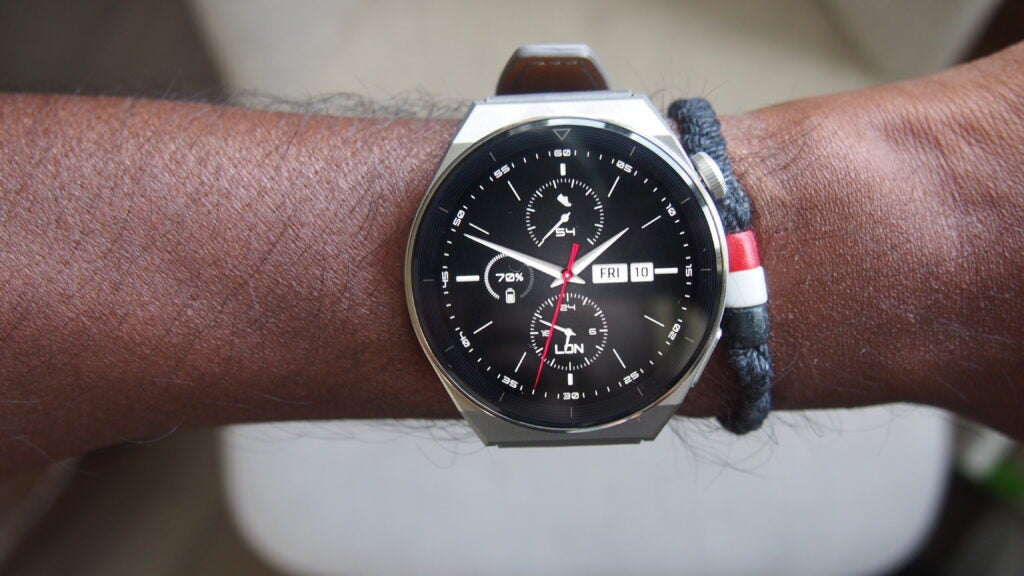
Design
- 42mm and 46mm case options
- AMOLED display
- Waterproof up to 50 metres
- Dive proof up to 30 metres
With the GT 3 Pro it really is all about the design here. Going Pro means swapping the stainless steel and plastic case back you get on the GT 3 for the option of a lighter titanium finish case or a white ceramic look.
I had the 46mm GT 3 Pro titanium version to live with, which has the same design characteristics as the similar sized non-Pro GT3. There’s a physical button and now a titanium rotating crown they feel great to use. That case is partnered up with a comfortable grey leather removable strap and you can additionally pick it up with a more workout-friendly fluoroelastomer strap or a titanium one if you want to go all in on the metal look. It looks slick, the 10.9mm thick case doesn’t feel too chunky and that titanium body means it’s a good weight too.
I actually thought the GT 3 wasn’t all that bad looking. There might be a bit more plastic at play, but up front that stainless steel isn’t all that bad.
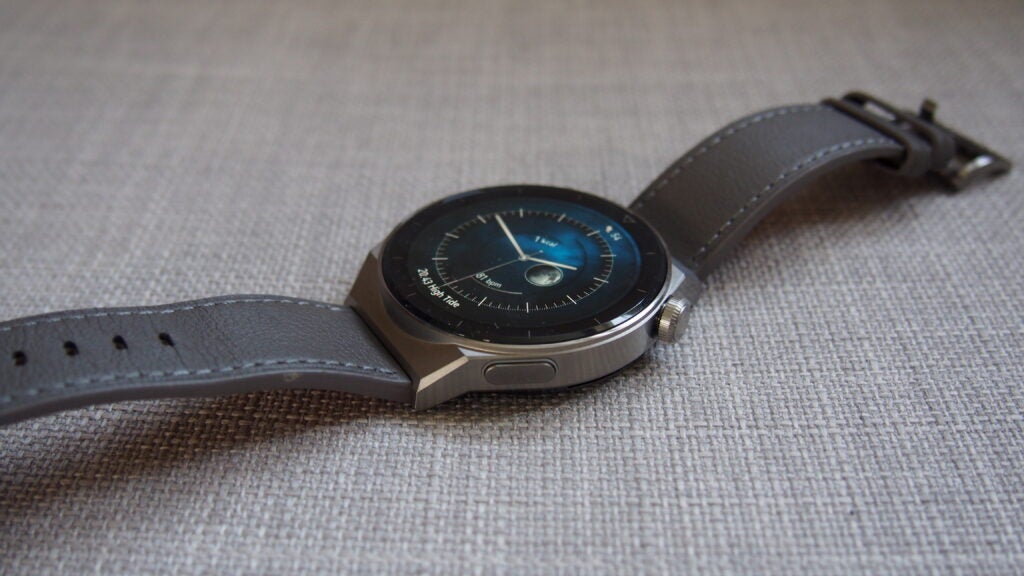
The real story here is with the 42mm version, which comes with a smaller screen but one that’s wrapped up in a more eye-catching ceramic case. There aren’t a lot of smartwatches out there that look like the ceramic option and it’s good to see Huawei offer something that clearly has women in mind.
Huawei has stuck with the same screen technology, with the 46mm version packing a pleasingly bright, colourful 1.43-inch, AMOLED screen. That is a display that can be set to an always-on mode and it’s a great quality one just like it is on the GT3. It’s nicely responsive to touch and there’s good viewing angles indoors and outdoors.
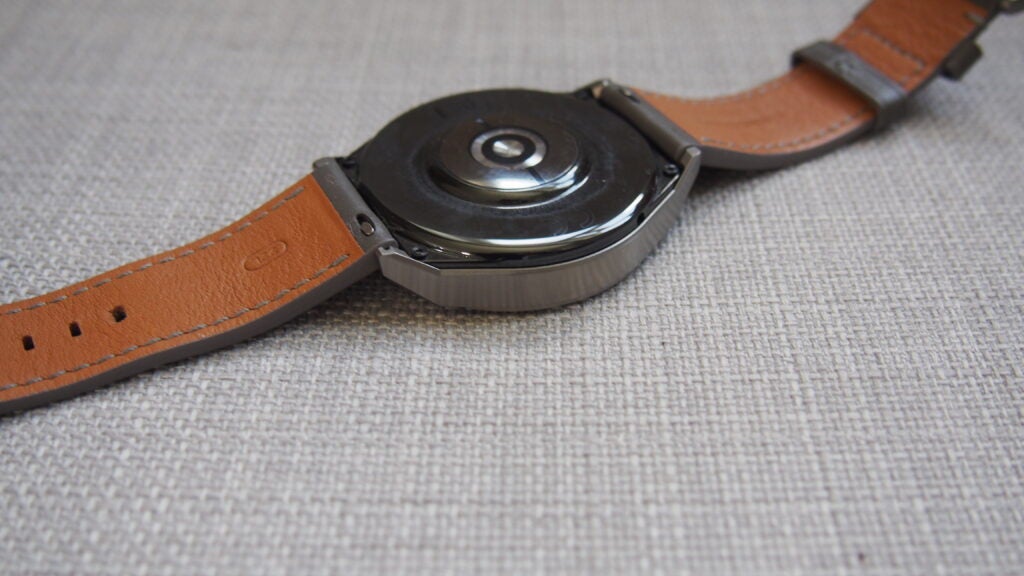
You’re getting the same level of waterproofing here too, though Huawei has also made the GT 3 Pro fit for free diving up to 30 metres depth. I haven’t put it to the freediving test, but if that’s your bag, then this is one of the few smartwatches that offers that level of protection outside of a swimming pool.
Tracking and features
- Free diving tracking
- 100+ workout modes including driving range
- Heart rate and SpO2 measurements
- View notifications, app store access and watch faces
- ECG support
Outside of a couple of extra sports modes and a new sensor, there isn’t a huge deal to report on the features front that hasn’t already been showcased on Huawei’s Watch GT 3 and the GT Runner. It runs on Harmony OS and works with Android and iOS devices, though you’ll get the most complete experience using it with Android and particularly Huawei smartphones.
The software and tracking experience on the whole is strong, but it does still lack in some places in comparison to other smartwatch platforms.
You’re getting a generous amount of sports tracking modes here along with new running-focused insights like assessing your running ability and viewing VO2 Max estimates. You can follow training plans, pair up an external heart rate monitor to get more reliable heart rate stats and you can upload and follow routes on the Pro too.
The big new additions are a freediving mode and a driving range mode, giving you activity-specific stats if you’re getting deep into the water or you’re grabbing your clubs. Outside of those it’s much the same as what I experienced using the GT3 and GT Runner.
Features like the dual-band five-system GNSS technology, which aims to improve outdoor accuracy performs well but still came up short for accuracy in comparison testing with the very accurate multiband support on Garmin’s latest watches. Swim tracking was solid and heart rate tracking during exercise overall was strong even at high intensity. Though, grabbing a chest strap is definitely the way to go if you value the heart rate-fueled insights on offer.
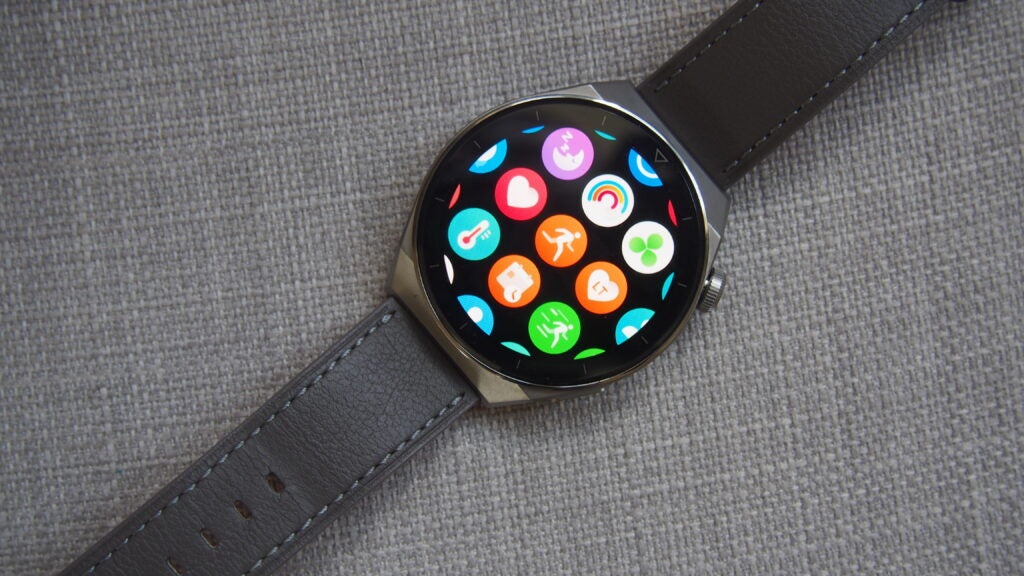
On the health and fitness tracking front, it offered good step tracking data compared to the Oura Ring 3 and Garmin and sleep data felt a bit more reliable compared to our time with the GT3. You still have Huawei’s Healthy Living clover, which is designed to nudge you when you drink water or smile more during the day, which isn’t going to be everyone’s cup of tea, but is a nice addition to help build a better daily routine.
You can also track skin temperature, SpO2, stress and there is an ECG sensor on board here, which you don’t get on the GT3 and is designed to help detect signs associated with atrial fibrillation. While support for that Apple Watch and Samsung Galaxy Watch-rivalling feature has started to roll out, it isn’t approved in the UK or Europe yet, so it’s going to be a feature some will have to wait to use.
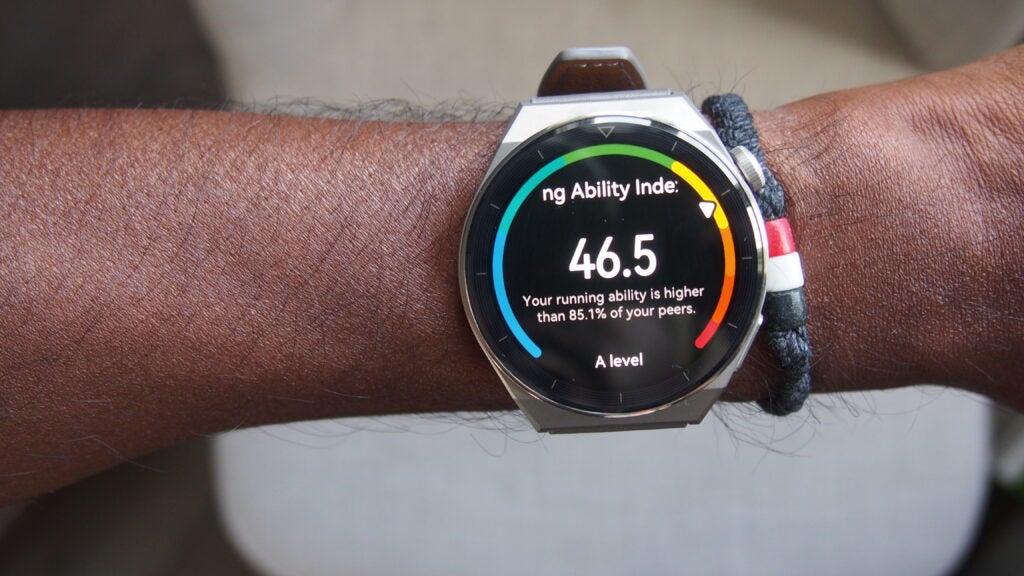
The GT 3 Pro does of course perform like a smartwatch too, and nothing has changed on that front. It’s a much better fit for Android and Huawei users. That’s because features like importing music and downloading apps from Huawei’s AppGallery storefront aren’t supported when it’s paired to an iPhone. If you want access to Huawei’s Celia smart assistant, that’s one for Huawei phone owners too.
What you will be able to access across the board is the ability to view notifications, control music playback, take calls via Bluetooth and there’s the ability to control your phone camera, though only when paired to Huawei phones and iPhones.
The smartwatch experience on the whole isn’t the best you’ll find on a smartwatch. The app store supports third party apps, but there’s not a load of them in there right now. Notification support varies across phone platforms and if you want to carry music on it, you’ll need to have purchased that music and sync it over from your phone. There’s a nice collection of pre-installed watch faces at least, but grabbing more from Huawei’s watch store does get pricey.
Battery Life
- Up to 14 days battery life in typical usage
- 8 days in heavy usage
- Improved charging speed
Huawei is quoting the same battery numbers for the GT3 Pro that it did for the GT3. It’s up to 14 days in what it calls ‘typical usage’ and then that drops to 8 days in heavy usage.
Those are the numbers attached to the 46mm titanium version. If you opt for the ceramic Pro, then that drops to 7 days in typical usage and 4 days in heavy usage.
I can only vouch for the performance of the larger 46mm version and I’d say those numbers ring true based on my time with it. It’s really not that different from what I experienced with the GT3.
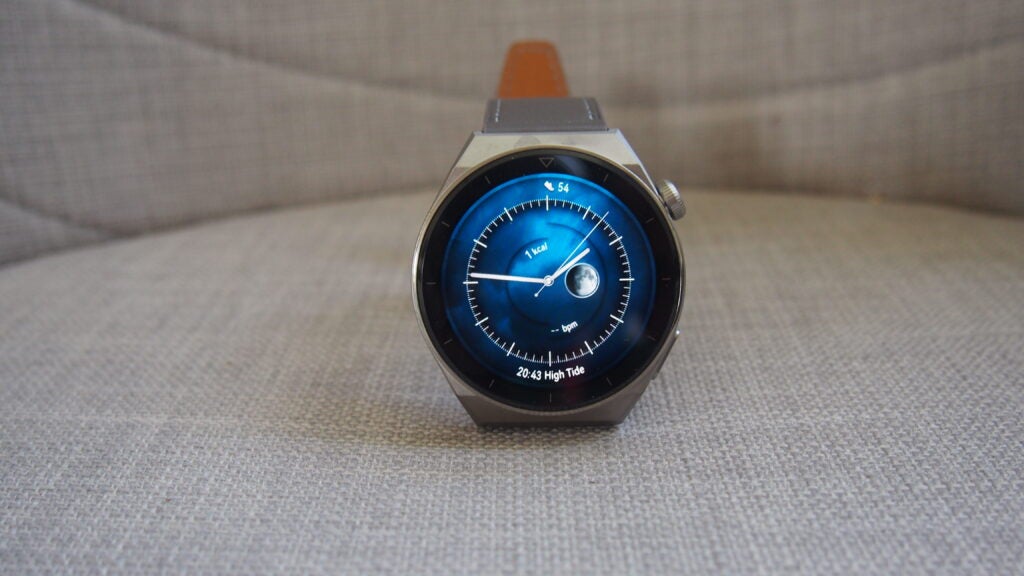
In heavy usage, enabling continuous heart rate monitoring and regularly using GPS, this is a watch that will get you through a week. If you can live without that continuous health monitoring and having the screen set to always-on, you can get this watch to go further and comfortably beyond a week.
One notable change from the GT3 is that Huawei is promising 30% quicker charging speeds, though it seems to be making a bigger deal about this on the 46mm version. 10 minutes of charging will get you 25% battery and it takes 85 minutes to get from 0-100%. That’s by no means the quickest charging speeds you can find on a smartwatch, but it might be a small reason to sway you from the non-Pro version of the GT3.
Should you buy it?
You want a slick smartwatch with good sports tracking features: Whether you go titanium or ceramic, the GT 3 Pro is a looker and has all of the strong features as the GT3 plus some big ones like ECG support when it goes live.
You own an iPhone: This smartwatch still feels like a better fit for Android and Huawei users. Big features like the music player and app store access are some of the things you’ll miss out on if you’re Team iPhone.
Final Thoughts
The Huawei Watch GT 3 Pro does deliver on the promise of a more elegant and high grade alternative to its GT 3 series smartwatches, but ultimately the software and features haven’t drastically changed. If you consider you can get the GT 3 for around £150 now and you can get similar performance, you really have to be sold on that titanium or ceramic look or that future ECG support because I think it’s probably highly likely those extra smarts will make their way to the GT3 at some point too.
FAQs
Yes, you can swim with the Huawei Watch GT 3 Pro as it carries a 5ATM waterproof rating, making it suitable to be submerged in water up to 50 metres depth. It’s also suitable to be used for diving up to 30 metres depth.
The Huawei Watch GT 3 Pro does work with iPhones, but it doesn’t support all features on offer. That includes importing music and accessing Huawei’s AppGallery app store.
Sustainability
TrustedReviews’ holds the fact that global warming is not a myth as a core value and will continuously endeavor to help protect our planet from harm in its business practices.
As part of this mission, whenever we review a product we send the company a series of questions to help us gauge and make transparent the impact the device has on the environment.
We currently haven’t received answers to the questions on this product, but will update this page the moment we do. You can see a detailed breakdown of the questions we ask and why in our sustainability info page.
Jargon buster
GPS
An abbreviation of the Global Positioning System, which uses satellite communication to pinpoint your location. Some smartwatches are able to achieve this communication without the use of a smartphone.
mAh
An abbreviation for milliampere-hour and a way to express the capacity of batteries, especially smaller ones in phones. In most cases the higher the mAh, the longer the battery will last but this isn’t always the case.
ECG
An abbreviation for ‘electrocardiogram’. This is a test which can now be performed on some smartwatches to determine if there are any signs of arrhythmia in a person’s heartbeat – fluctuations that can result in severe health issues.
OLED and AMOLED
Types of displays that use self-lighting pixels to provide greater contrast and more vibrant colours than a typical LCD display, as well as sharper blacks.
















